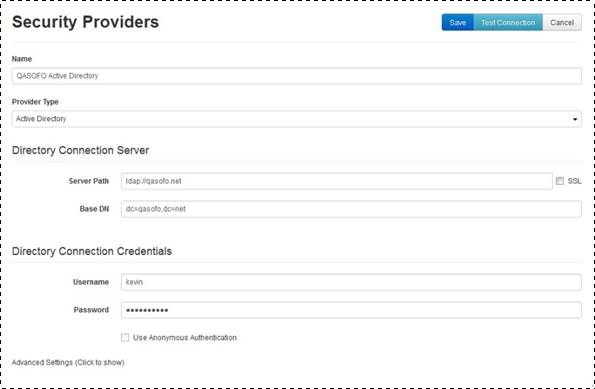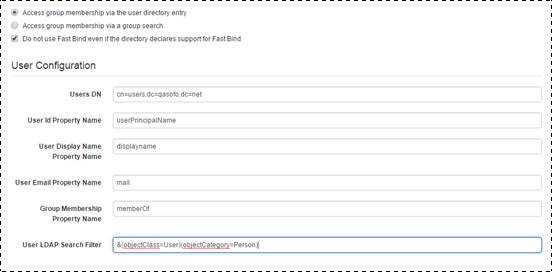
Use Management Portal to connect Mediasite to a LDAP directory that stores the credentials of users and groups on your network.
To connect Mediasite to a LDAP directory:
1. Click Security > Security Providers > Add New and specify the settings needed to connect to the directory:
|
Settings |
Details |
|
Name |
Enter the name of the provider. |
|
Provider Type |
Choose, LDAP Directory. |
|
Server Path |
Enter the path of the directory. The path should include the FQDN or IP address of the server where the directory is located and the port. The default LDAP port is 389. The server path will have the following format: LDAP://servername.company.net:389 |
|
SSL |
Select this check box if you already have Secure Socket Layer configured on your system. When SSL is used, the SSL port should be used in the Directory Server Path. The default LDAP SSL port is 636. |
|
Base DN |
Enter the distinguished name for the top level of the directory. |
|
Username/Password |
Enter the credentials needed to connect to the directory. |
|
Use Anonymous authentication |
Select this check box to connect to an LDAP directory that does not require user credentials. |

Security Provider (Active Directory) basic settings
2. Click Advanced Settings to view additional settings.
3. Specify the method used to access group information in the directory:
|
Settings |
Details |
|
Access group membership via the user directory entry |
Select this radio button to determine group membership by inspecting the group membership property of the user directory entry. |
|
Access group membership via a group search |
Select this radio button to determine group membership by searching the group member property of group directory entries. |
|
Do not Use Fast Bind even if the directory declares support for Fast Bind |
Select this option to disable concurrent binds (fast binds) for this directory connection. In most scenarios, you will leave this option unselected. However, if you have a directory that falsely claims fast bind support; select this option to ensure the directory connection works as expected. |
4. Specify user configuration settings, used to locate users in the directory:
|
Settings |
Details |
|
Users DN |
The distinguished name for the user directory. |
|
User Id Property Name |
The attribute used to identify a User ID in the directory. |
|
User Display Name Property Name |
The attribute used when displaying users. |
|
User Email Property Name |
The attribute used to identify the primary email address for the user. |
|
Group Membership Property Name |
The attribute used to identify a user’s group memberships. |
|
User LDAP Search Filter |
The filter to use when searching the directory for users. |

Security Provider (Active Directory) advanced settings, user configuration
5. Specify group configuration settings, used to locate groups and identify group membership:
|
Settings |
Details |
|
Groups DN |
The distinguished name for the group directory. |
|
Group Id Property Name |
The attribute used to identify a group in the directory. |
|
Group Display Name Property Name |
The attribute used when displaying groups. |
|
Group Member Property Name |
The attribute used to identify a group member in the directory. |
|
Group LDAP Search Filter |
The search filter to use when searching the directory for groups. |
|
Perform a nested group search |
This check box is selected by default for LDAP. When selected, each sub-group within a group is searched for users as part of a group search. Clear this check box if you don’t want to search subgroups for users. |
|
Determine group membership using security groups |
When selected, security groups are searched including nested ones. Distribution lists are not searched. |

Security Provider (Active Directory) advanced settings, groups configuration
6. Specify search configuration and user profile provisioning settings:
|
Settings |
Details |
|
Page Size |
The maximum number of entries displayed in the search results. |
|
Automatically create User Profiles on Login to My Mediasite or Management Portal |
Select to this to have Mediasite create user profiles automatically using the User Email Property Name and a Display Name Attribute. |
|
Display Name Attribute |
Enter the attribute that will be used to create the user profile. You can customize the display name using concatenated strings that include plain text strings and LDAP/AD attributes. |

Security Provider (Active Directory) advanced settings, search and user profile provisioning
7. Click Save. Click Test Connection to verify the directory connection using the settings above.